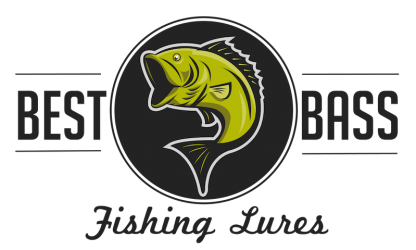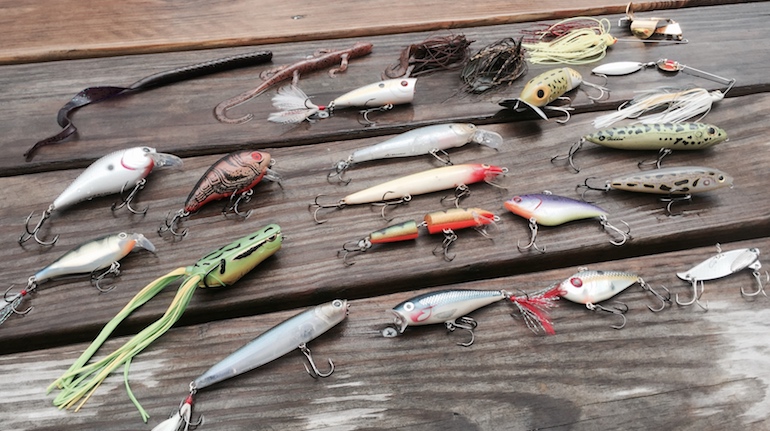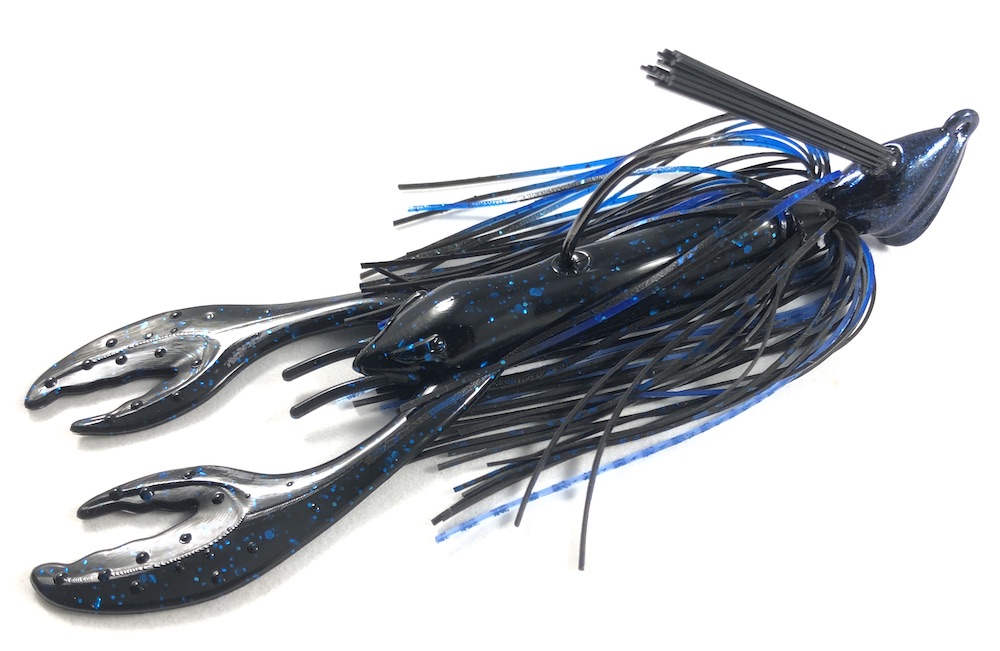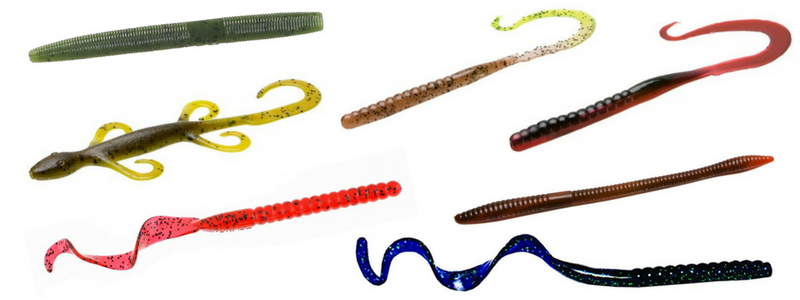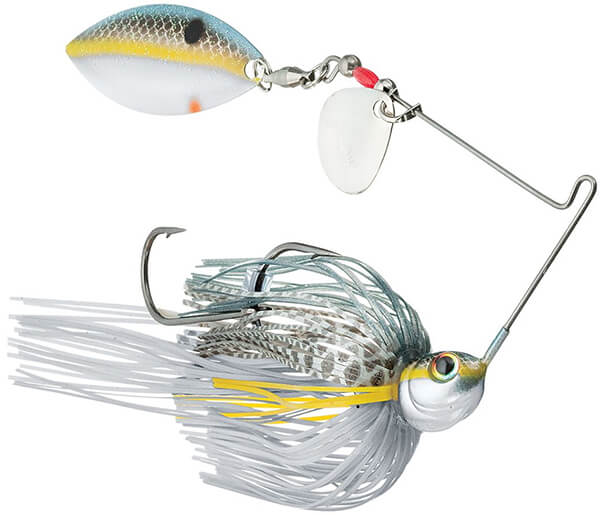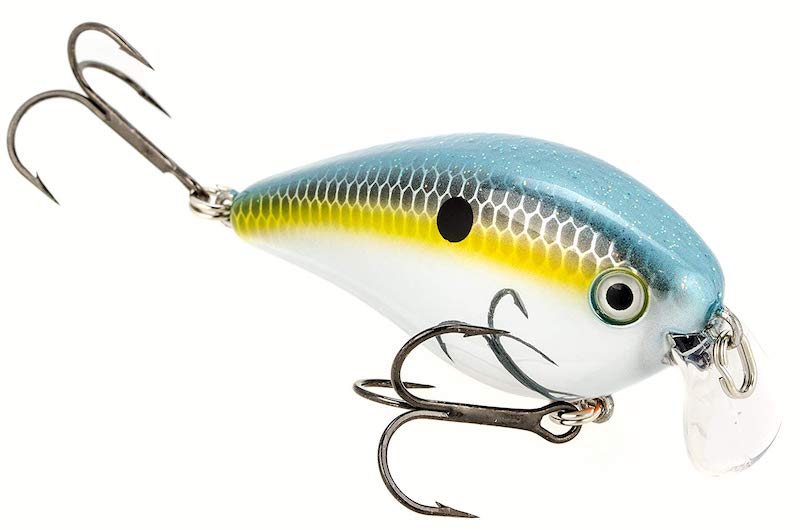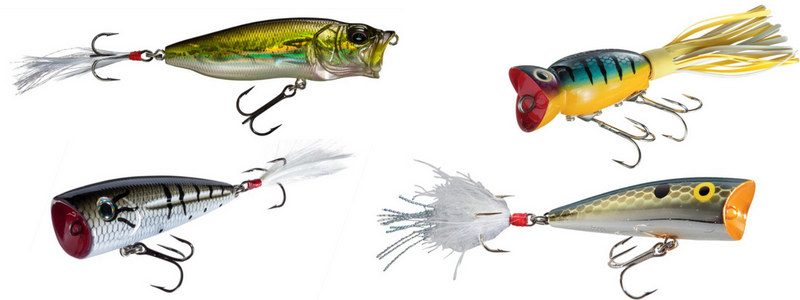Selecting and collecting bass lures is almost as enjoyable as actually fishing them. But which lures catch the most bass?
So many factors come into play when trying to pick the best bass lures for a day of fishing. Things like weather, time of year, time of day, or water clarity are just a few of those factors.
So instead of focusing on specific situations, we broke down the top five best bass lures based on their overall proven ability to consistently catch bass, catch big bass, and their versatility.
If you want to learn more about a specific bass lure and when it is best for certain situations you can browse through the menu options above.
1. Bass Jigs
We start with bass jigs because of their versatility. You can effectively fish an entire body of water, during any season, with a single jig. They can also can get in to areas most other lures can’t and be fished in so many different ways.
There are different types of bass jigs designed for certain techniques, but the most popular type is the arkie jig. The jig in the photo above is an arkie jig, and can cover most jig fishing techniques. You can flip and pitch them, skip them, work deep water with them, and/or swim them.
Bass jigs are always paired with some kind of a trailer, which in most cases will be some kind of an imitation craw trailer. Or if you’re swimming a jig, a paddle tail swimbait trailer.
Another reason jigs are number one on the list is because jigs get big bass to bite, more so than most other lures. However, mastering jigs and all the different ways to fish them takes practice. So if you’re going to invest time on any lure, jigs are your best bet.
Advantages
- Weedguard equipped
- Effective year-around
- Big fish bait
- Can fish deep or shallow
Disadvantages
- Takes some getting used to
- Fishes slow
- Trailers sold seperate
2. Plastic Worms
At a very close second are rubber worms. Rubber worms feel so lifelike to a bass that when they bite they tend to hold on longer, giving the angler more time to set the hook.
Also there is no other lure that can be rigged as weedless as a rubber worm. You can bury the hook point in to the body of the worm making it completely snag-proof and allowing it to get in to very weedy areas. The point will expose itself when you set the hook, executing a good hook set is essential in worm fishing.
There are a handful of popular ways to effectively rig a rubber worm, and how you choose to rig will be based on what presentation you are looking to achieve. Some of the most common worm rigs are the Texas rig, the Wacky rig, the Ned rig, the Carolina rig, and the Drop Shot rig.
And lastly, there are endless styles, sizes, and colors of rubber worms to choose from. This allows you to really zero in on the best presentation for the fishing situation you are in.
Advantages
- Can be rigged weedless
- Effective year-around
- Easy to fish
- Wide variety of styles
Disadvantages
- Tears easily
- Fishes slow
- Hooks sold seperate
3. Spinnerbaits
Spinnerbaits come in at number three because of their unique ability to attract bass while covering a lot of water quickly. And they are pretty simple to fish, for the most part spinnerbait fishing is done simply by reeling the bait in a straight retrieve.
As a spinnerbait travels through the water the blade (or blades) spin rapidly. The purpose of the blade is to attract a bass’s attention with flash and vibration. The flash is obviously a visual attractant, but the vibration is not only heard but felt by a bass through its lateral line.
The blades also give the bait some resistance in the water. There are different styles of blades that will affect the level of resistance, increasing or decreasing the speed at which it travels. The most common blades are Willow blades, Colorado blades and Indiana blades.
Advantages
- Attracts with flash and vibration
- Fast moving for covering water
- Long lasting
- Easy to fish
Disadvantages
- Not very weedless
- Conditions have to be right
- Components can rust
4. Crankbaits
Crankbaits are a tremendous option for targeting fish in open water at various depths. It’s one of the few baits that gives you full control of the depth you’re looking to target. This control comes from the lip on the front of the bait. It creates resistance in the water that causes the bait to wobble and dive.
The amount of wobble and diving depth are the two factors an angler needs to consider when choosing a crankbait. The size, shape, and angle of the lip, along with the location of the line-tie is what determines how much wobble or diving depth a crankbait will have.
Every crankbait will have its diving depth range listed on the packaging, and you can gauge how wide the wobble will be by they width of the lip. It’s general crankbait knowledge that tighter wobbles work best in cold water, while a wider wobble is more effective in warm water.
Advantages
- Choice of rattle or no rattle
- Fast moving for covering water
- Long lasting
- Can upgrade hooks
Disadvantages
- Not weedless
- Works best with a crankbait rod
- Components can rust
5. Poppers
In bass fishing, little can compare to the enjoyment an angler gets when seeing a bass leap out of the water in an attempt to engulf a popper lure. Poppers are not only effective but extremely fun to use, which easily puts them in the top 5.
These lures are designed to ripple the water’s surface, making popping and splashing sounds as they are retrieved. These baits are designed to create the appearance of prey in distress, a sound that is hard for a bass to resist. The biggest downside to these and all topwater lures is bass can miss them when they aggressively jump through the surface.
One of the best features of a popper is you can fish them as fast or as slow as you want. This allows you to make adjustments and dial in on what the bass want that day. Sometimes an aggressive chugging retrieve works best while other times letting the popper float in place for up to a full minute can trigger a strike.
Topwater fishing is at its best in low light conditions. This includes early mornings, late afternoon/night, or on an overcast day. Wind also plays a factor. Having a light ripple on the surface is ideal, but anything more than that is no good.
Advantages
- Attracts with noise
- Visual strikes
- Long lasting
- Can upgrade hooks
Disadvantages
- Conditions have to be right
- Fish can miss them
- Warm water only
How To Choose The Best Bass Lures
The thoughts and opinions on what bass fishing lures are the best will vary from angler to angler. And that’s a good thing! Every angler is built differently, some are stronger, some have more patience, or some simply enjoy fishing some lures more than others.
Bass fishing is a mental sport, and a ton of what makes a lure the best for a particular angler is the amount of confidence he or she has in it. It’s better to to build confidence in a specific lure and become an expert with it than to try and master all of them. Even the pro’s excel with certain lures.
Follow The Bait Money
Bass are the most sought-after gamefish in the United States, and rank number one in terms of how much money is spent on equipment for catching them. This has led to amazing developments in all sorts of bass fishing gear, much of which are lures.
It’s great that bass fishermen have such a wide variety of lures available to them, but it also creates a lot of confusion when trying to decide which ones to buy. This is especially true for beginners selecting lures.
Of course not all lure manufacturers will always have your best interests in mind. Some of their focus can lean more towards what entices anglers to buy rather than bass to bite.
This is usually done by focusing more on the look of a bait rather than the performance. But also through marketing tricks or by simply selling poorly-made lures for lower prices.
Price vs Quality
Some lures are similar in appearance but have significantly different prices. Does that mean a more expensive lure is going to catch more fish? Not necessarily, it has way more to do with the skill level of the angler using it.
Ninety-nine times out of a hundred a seasoned angler fishing a Bandit crankbait is going to outfish a novice angler fishing a Lucky Craft crankbait, regardless of the price difference being more than double.
That’s one of the main attractions of bass fishing, it can be as modest or extreme as you want it to be. It is definitely possible to catch bass with nothing more than a single fishing rod and cheap tackle from shore. Or, you can spend thousands on a bass boat loaded with the top of the line tackle.
You can’t buy your way to being a good bass fisherman, nor can you buy absolute junk tackle and expect to have consistent success bass fishing. This is where doing research pays off, by not falling for overpriced or poorly-made lures that look like a great deal.
Finding The Best Lure Brands
It’s important to be weary of extreme prices in either direction without knowing why. There are some things in fishing that are indisputable, like Owner and Gamakatsu being two of the best hook brands around.
So if a lure is made with one of these brands of hooks then that’s an example of why a price may be higher.
It’s also a reason that you should learn about different fishing brands and their level of quality. And it’s never been easier than it is today with the internet and social media. It’s nearly impossible to fool fisherman today, say like the helicopter lure did back in the 90’s.
Not only did the internet help expose gimmick baits but it helped a lot of good quality lures made by smaller brands gain attention. So if you’ve never heard of a brand do a little research in to how they make their baits and what people have to say about them.
That’s one of the main purposes of this website. Not only to make you a better fishermen, but to help you wade through the thousands of bass lures and brands out there and select the best bass lures for you, your budget, and the conditions you’re fishing.
